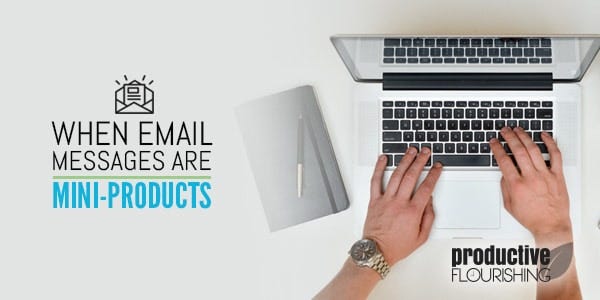When Email Messages Are Mini-Products

Something has always bugged me about the common advice about email correspondence. It was only when I was talking to Naomi yesterday that it really hit me: for many of us, email messages are a mini-product. They're connective tasks that are also creative tasks.
Not every email is like this, of course. Some fall within the standard "2 minute, 5 sentence rule." But many of us use email correspondence to do more than coordinate with folks, and that's where the rub is.
We've heard over and over again - and it's true - that every interaction you have with your prospects, clients, or customers is a chance to reinforce your brand. Every email you send to people not in your friend-and-family circle is an interaction with a prospect, client, or customer.
There may be certain environments where answering people's questions in 2 minutes and 5 lines is okay - I suppose that a short answer is better than no answer at all, given the reality of the overflowing Inbox. However, answering the question of someone wanting to pay for a service or product from you usually requires much more than that.
Take the standard "Which product should I buy?" question that many creatives get. Usually, those questions contain specific information that requires some thought. They contain a tone that needs to be addressed. There's a real person on the other end who is fundamentally interested in buying what you've got. Crafting an effective response that addresses the needs, mood, and humanity on the other end of the line in a way that reinforces your brand is not at all a mechanical act - it's a creative one.
Likewise if you're offering a service and you get the "How long will this take?" or "how much will this cost me?" question. You're doing far more than answering that question - you're indicating what your interactions will be like, how you'll address your prospect's needs, etc. Not only that, but you're being compared to either the message of your website or the nature of the way that person found you; this is yet another way of saying that you're reinforcing your brand.
My point here: there's writing email, and then there's creatively connecting with people. They're different types of acts that require different types of work. Do your creative, connect-ey type emails during focus blocks - they're their own little creations and must be treated as such.
If you're not comfortable with letting those messages that require that type of work sit in your Inbox or in their own folder, take the time to craft a creative, brand-resonant message template that indicates that you have their message (you're prompt) and you're working on an individualized response to their inquiry (this says "you're important to me and I want to give your needs due consideration, but I can't right now") and will get back to them soon. Whatever you do, don't forget to write that second email.
At the end of the day, these types of emails are what put food on the table - they sell your products and services more than your products and services sell themselves. Put the same amount of effort into them as you do your other products and services.
All of this is obvious and common-sense, but that's precisely why it bears consideration.




